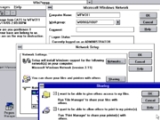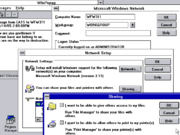
Messenger Service
Encyclopedia

Microsoft Windows
Microsoft Windows is a series of operating systems produced by Microsoft.Microsoft introduced an operating environment named Windows on November 20, 1985 as an add-on to MS-DOS in response to the growing interest in graphical user interfaces . Microsoft Windows came to dominate the world's personal...
. This service, although it has a similar name, is not related in any way to the .NET Messenger Service
.NET Messenger Service
The .NET Messenger Service is an instant messaging and presence system developed by Microsoft in 1999 for use with its MSN Messenger software and used today by its current instant messaging clients, Windows Live Messenger and Microsoft Messenger for Mac...
or the Windows Messenger
Windows Messenger
Windows Messenger is a client by Microsoft that is included in the Windows XP operating system. Designed for use by corporate users as well as home users, it was originally created as a streamlined and integrated version of MSN Messenger...
and MSN Messenger/Windows Live Messenger
Windows Live Messenger
Windows Live Messenger is an instant messaging client created by Microsoft that is currently designed to work with Windows XP , Windows Vista, Windows 7, Windows Mobile, Windows CE, Xbox 360, Blackberry OS, iOS, Java ME, S60 on Symbian OS 9.x and Zune HD...
instant messaging clients.
WinPopup
Winpopup sends messages from one Windows computer to another on the same LANLocal area network
A local area network is a computer network that interconnects computers in a limited area such as a home, school, computer laboratory, or office building...
. It is available in all Windows versions from Windows for Workgroups 3.1 to Windows Me
Windows Me
Windows Millennium Edition, or Windows Me , is a graphical operating system released on September 14, 2000 by Microsoft, and was the last operating system released in the Windows 9x series. Support for Windows Me ended on July 11, 2006....
, but has never been included with Windows NT
Windows NT
Windows NT is a family of operating systems produced by Microsoft, the first version of which was released in July 1993. It was a powerful high-level-language-based, processor-independent, multiprocessing, multiuser operating system with features comparable to Unix. It was intended to complement...
-based operating systems.
There is also a port to Linux
Linux
Linux is a Unix-like computer operating system assembled under the model of free and open source software development and distribution. The defining component of any Linux system is the Linux kernel, an operating system kernel first released October 5, 1991 by Linus Torvalds...
with an extended feature called LinPopUp, which allows adding Linux computers to the set. Linpopup is an X Window graphical port of Winpopup, and a package for Debian linux. It runs over Samba
Samba (software)
Samba is a free software re-implementation, originally developed by Andrew Tridgell, of the SMB/CIFS networking protocol. As of version 3, Samba provides file and print services for various Microsoft Windows clients and can integrate with a Windows Server domain, either as a Primary Domain...
. Linpopup does not have to run all the time, can run minimized, and its messages are encrypted with a strong cypher.
Abuse

IP address
An Internet Protocol address is a numerical label assigned to each device participating in a computer network that uses the Internet Protocol for communication. An IP address serves two principal functions: host or network interface identification and location addressing...
es). Even though Windows XP includes a firewall
Firewall (computing)
A firewall is a device or set of devices designed to permit or deny network transmissions based upon a set of rules and is frequently used to protect networks from unauthorized access while permitting legitimate communications to pass....
, it is not enabled by default. Because of this, many users received such messages. As a result of this abuse, the Messenger Service has been disabled by default in Windows XP Service Pack 2, a change perhaps redundant as the same service pack also enabled the firewall by default.
In order to use the Messenger Service functionality of Windows through the NET SEND command, either by itself or with the use of a third party NetBIOS messaging application, it is recommended that the NetBIOS ports cannot be reached from sources external to the local network. The ports that can be used by the Messenger service are 135, 137, 138, and 139. Many Internet service provider
Internet service provider
An Internet service provider is a company that provides access to the Internet. Access ISPs directly connect customers to the Internet using copper wires, wireless or fiber-optic connections. Hosting ISPs lease server space for smaller businesses and host other people servers...
s currently block access to these NetBIOS ports over the Internet, helping to prevent spamming even for older unfirewalled clients.
The Messenger Service is no longer supported from Windows Vista
Windows Vista
Windows Vista is an operating system released in several variations developed by Microsoft for use on personal computers, including home and business desktops, laptops, tablet PCs, and media center PCs...
and Windows Server 2008; instead it was replaced with the old MSG.exe.
Architecture
The Messenger Service, unlike many other network utilities included with Windows, uses the NetBIOSNetBIOS
NetBIOS is an acronym for Network Basic Input/Output System. It provides services related to the session layer of the OSI model allowing applications on separate computers to communicate over a local area network. As strictly an API, NetBIOS is not a networking protocol...
protocol. The service waits for a message, then it displays it onscreen. The alternative way to send a message is to write it to a MailSlot
MailSlot
A MailSlot is a type of interprocess communication that allows communication between processes both locally and over a network. The use of MailSlots is generally simpler than named pipes or sockets, but they are more limited.-Features:...
named messngr.
See also
- Comparison of instant messaging protocols
- Comparison of instant messaging clientsComparison of instant messaging clientsThe following tables compare general and technical information for a number of instant messaging clients. Please see the individual products' articles for further information. This article is not all-inclusive or necessarily up-to-date...
- Comparison of LAN messengersComparison of LAN messengers-General information:Basic general information about the LAN messengers: creator/company, license/price, among others.-Operating system support:The operating systems the messengers can run on without emulation or compatibility layers.-Features:...
- LAN messengerLAN messengerA LAN messenger is an instant messaging program designed for use within a single local area network .There are advantages using a LAN messenger over a normal instant messenger. The LAN messenger runs inside a company or private LAN, and so an active Internet connection or a central server is not...
- Alerter serviceAlerter serviceThe Alerter service is a Microsoft Windows service which is used to send administrative alerts. It alerts users about security, access, and user session problems...
- List of Microsoft Windows components
- Messaging spamMessaging spamMessaging spam, sometimes called SPIM,is a type of spam targeting users of instant messaging services.-Instant messaging applications:...
External links
- Official Microsoft sources
- Knowledgebase entry for Messenger Service of Windows
- Command documentation for Net send
- Disabling The Messenger Service in Windows XP

